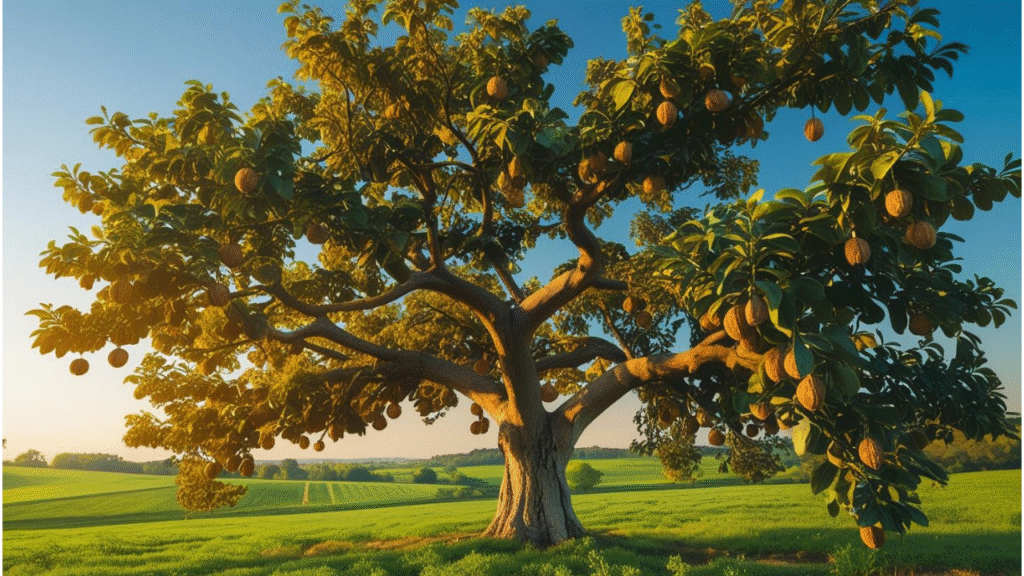
Where Do Walnut Trees Grow? Best Climates, Regions, and Growing Conditions Explained
Table of Contents
Toggle🌳✨ What Are Walnut Trees? A Quick Overview ✨🌳
Walnut trees are some of the most versatile and valuable trees in the world. 🌍 Known for their delicious nuts 🌰 and high-quality wood 🌲, these trees have been cultivated for centuries for both practical and aesthetic purposes. 🌱 But what exactly makes a walnut tree so special? Let’s take a closer look! 👀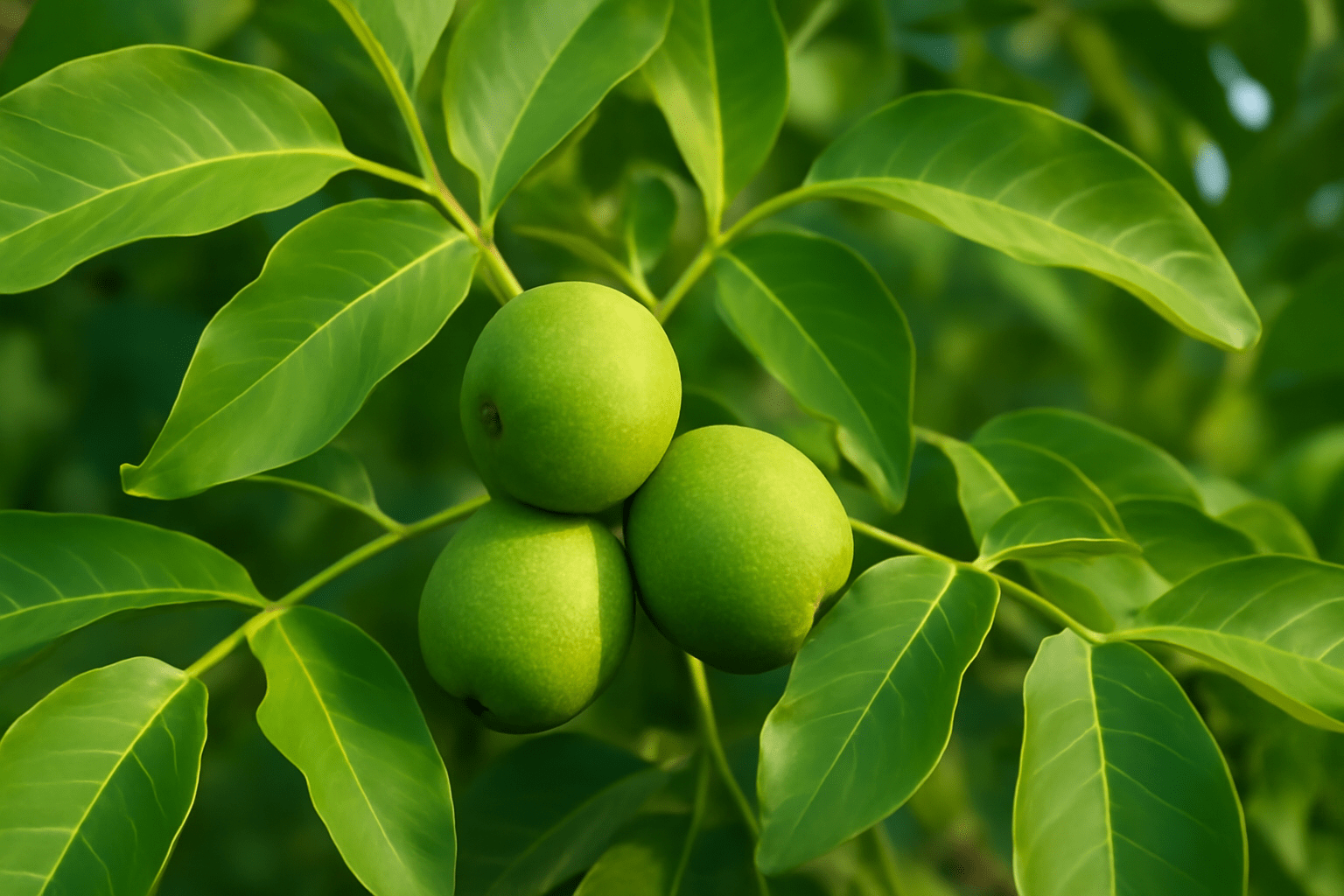
🌰 Meet the Walnut Tree Family
Walnut trees belong to the Juglans genus, which includes several species. 🌳 The two most popular types are:English Walnut (Juglans regia):
Also known as Persian walnut, this is the tree most commonly grown for its large, flavorful nuts. 🌰Black Walnut (Juglans nigra):
Native to North America 🇺🇸, this tree is prized for its dark, durable wood 🌲 and smaller, rich-flavored nuts. 🌰 Both types are deciduous 🍂, meaning they lose their leaves in the fall 🍁, and they can grow into magnificent, towering trees 🌳 that add beauty and value to any landscape. 🌿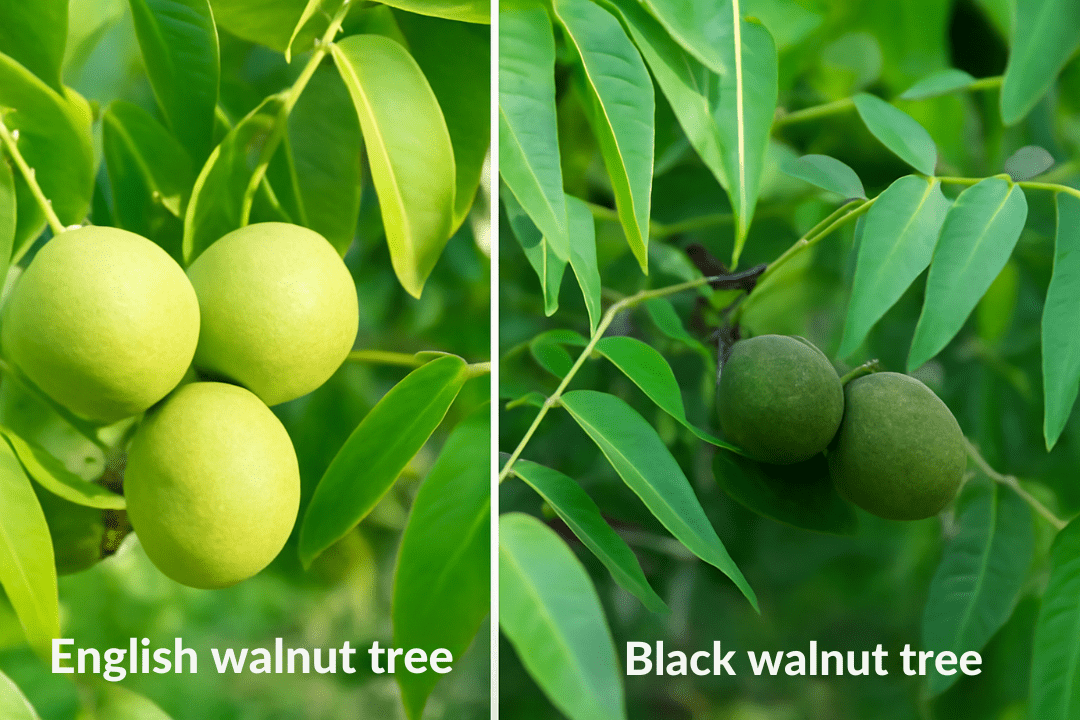
🪵 Why Are Walnut Trees So Valuable?
Walnut trees are more than just nut producers—they’re true multitaskers! 💪 Here’s why they’re so highly regarded:Nut Production 🌰:
Walnuts are packed with nutrients like omega-3s, antioxidants, and protein, making them a popular choice for healthy diets. 🥗Timber 🪵:
Black walnut wood is one of the most sought-after hardwoods, used for furniture, flooring, and even musical instruments. 🎻Shade and Beauty 🌳:
Their wide, spreading canopies make them excellent shade trees, perfect for gardens 🌻 and open spaces. 🏞️🌍 Where Do Walnut Trees Come From?
Walnut trees are native to different parts of the world:English Walnut 🌰:
Originally from Central Asia and the Middle East 🌍, it has spread across Europe 🇪🇺, North America 🇺🇸, and beyond 🌏.Black Walnut 🌰:
Native to the eastern United States 🇺🇸, it thrives in temperate climates 🌤️ across North America.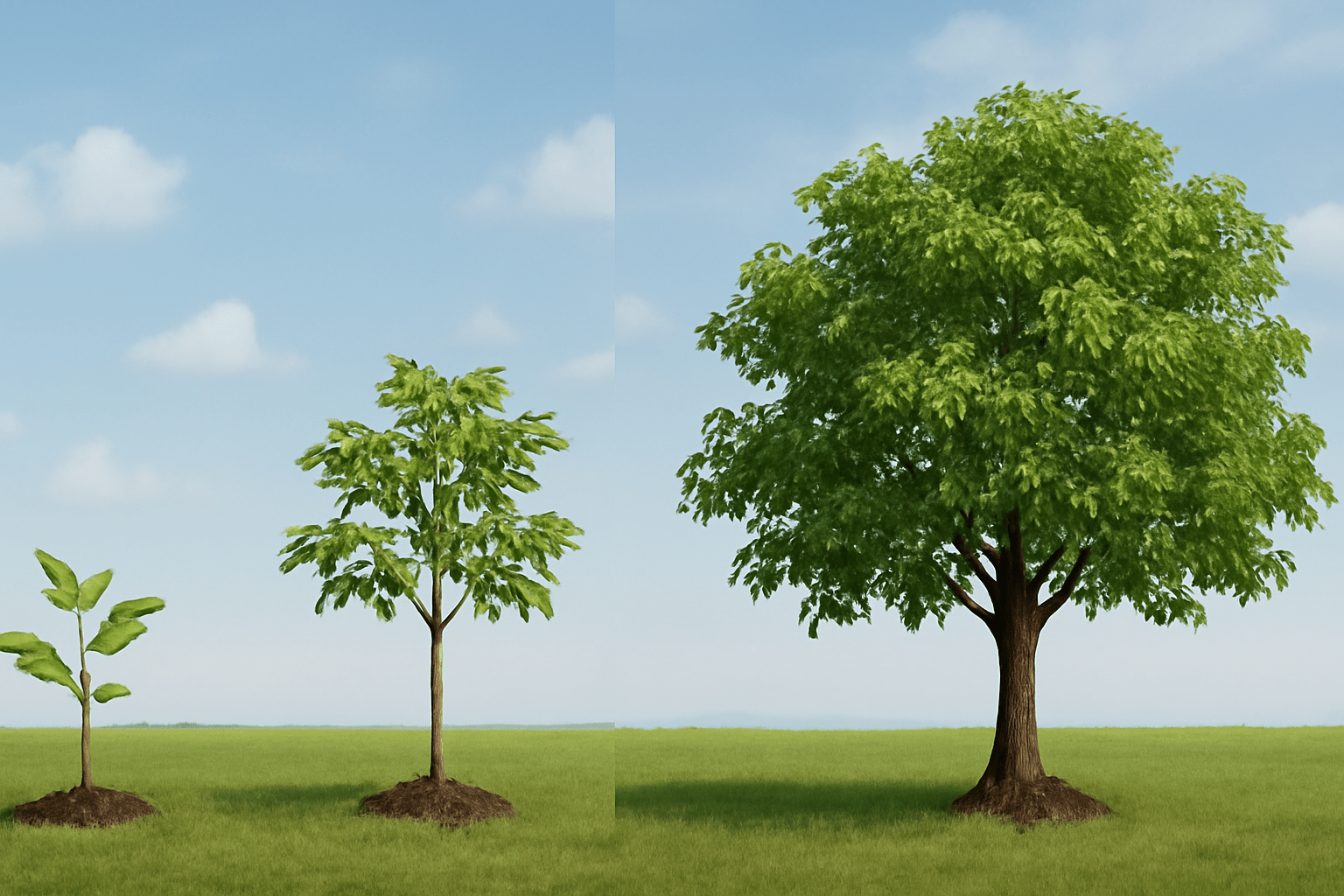
💡 Fun Fact:
Did you know that walnut trees produce a natural compound called juglone? 🧪 While it helps the tree protect itself from competing plants 🌱, it can make it tricky to grow certain crops nearby 🌻. Keep this in mind when planting! 🌱 In short, walnut trees 🌳 are a perfect blend of beauty, utility, and sustainability 🌱. Whether you’re growing them for nuts 🌰, wood 🪵, or simply to enjoy their shade 🌳, understanding their characteristics is the first step to cultivating these incredible trees. Ready to dive deeper into where they grow best? Let’s keep going! 🚀🌎🌳 Where Do Walnut Trees Naturally Grow? 🌳🌎
Walnut trees have a fascinating history and grow naturally in a variety of regions across the globe 🌍. From the lush forests of North America 🌲 to the sunny hillsides of Central Asia 🌞, these majestic trees thrive in temperate climates with the right balance of warmth and moisture 💧. Let’s explore where walnut trees call home! 🌱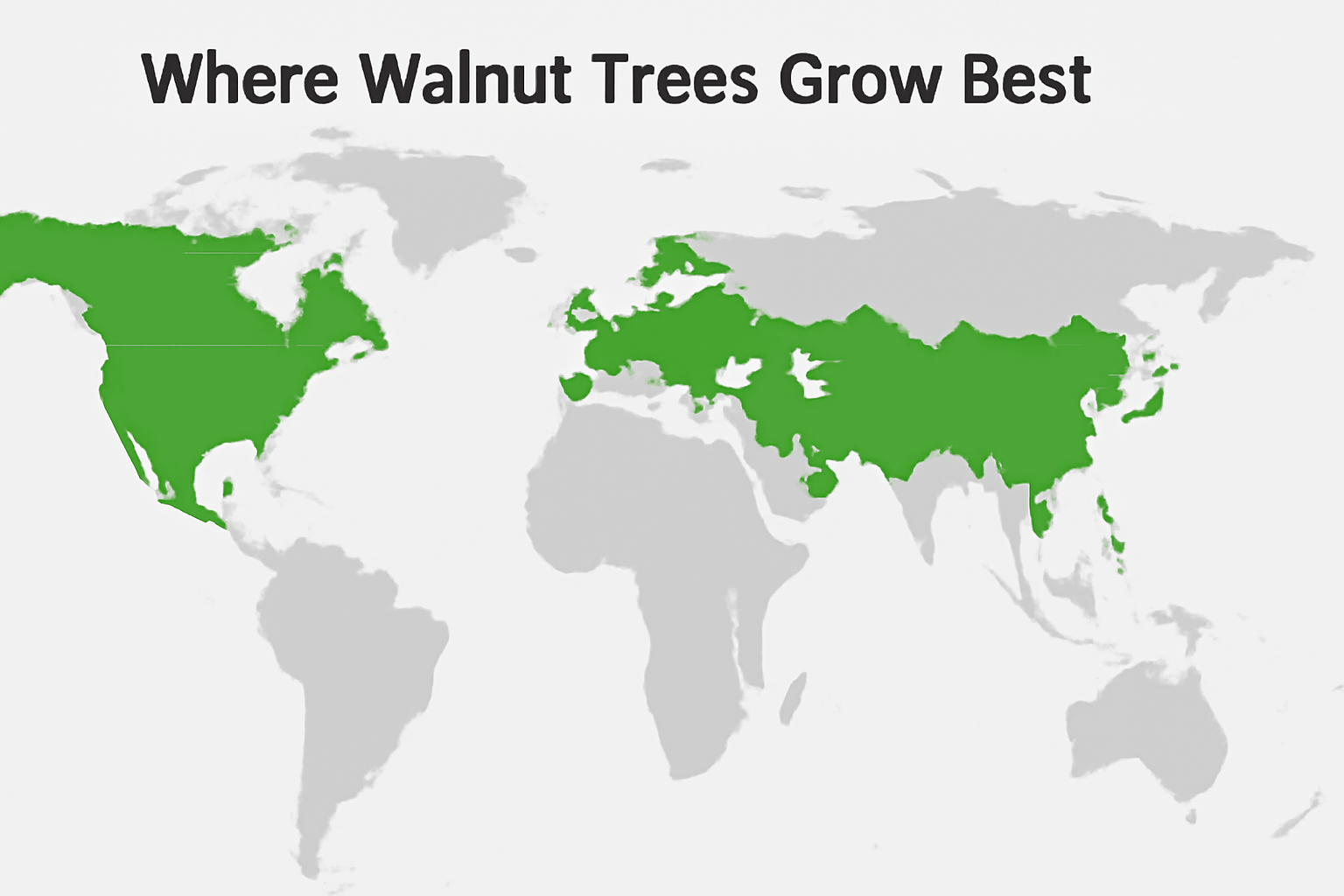
🌰🌍 Native Regions of Walnut Trees 🌍🌰
Walnut trees are native to specific parts of the world 🌍, depending on the species:🌰🌍 English Walnut (Juglans regia) 🌍🌰
Originates from Central Asia and the Middle East 🌍, particularly in regions like modern-day Iran, Afghanistan, and surrounding areas 🌏. Over centuries, it spread to Europe 🇪🇺 and eventually to North America 🇺🇸. Today, it’s widely cultivated in temperate regions worldwide 🌎.🌳🌍 Black Walnut (Juglans nigra) 🌍🌳
Native to the eastern United States 🇺🇸, from the Great Plains to the Appalachian Mountains 🏞️. Found naturally in states like Indiana, Missouri, and Pennsylvania, where it thrives in rich, fertile soils 🌱. These trees have adapted to their native environments 🌿, but they’ve also been introduced to other areas where conditions are favorable 🌳.☀️🌿 What Makes These Regions Ideal? 🌿☀️
Walnut trees naturally grow in areas with:🌞🌱 Temperate Climates 🌱🌞
Moderate winters ❄️ and warm summers 🌞 are essential for their growth 🌱.🌍🌿 Fertile Soil 🌿🌍
Deep, well-drained soils 🏞️ rich in nutrients provide the best foundation for these trees 🌳.🌧️🌱 Consistent Rainfall 🌱🌧️
While walnut trees 🌳 can tolerate some drought once established 🌵, they thrive in areas with steady, moderate rainfall 🌦️.🌍🌳 Where You’ll Find Walnut Trees Today 🌳🌍
Thanks to their adaptability 🌱, walnut trees 🌳 are now found in many parts of the world 🌎, including:🇺🇸🌰 North America 🌰🇺🇸
The United States 🇺🇸 is a major producer, especially California 🌞, which is famous for its English walnut orchards 🌰.🇪🇺🌰 Europe 🌰🇪🇺
Countries like France 🇫🇷, Italy 🇮🇹, and Romania 🇷🇴 are known for their walnut production 🌰.🇨🇳🌰 Asia 🌰🇨🇳
China 🇨🇳 is the world’s largest walnut producer 🌰, followed by Iran 🇮🇷 and India 🇮🇳.🇦🇷🌰 South America 🌰🇨🇱
Argentina 🇦🇷 and Chile 🇨🇱 have become popular regions for walnut cultivation due to their favorable climates 🌞.💡🌍 AEO-Style Answer 🌍💡
“Walnut trees naturally grow in temperate regions across North America 🌎, Europe 🇪🇺, Asia 🇨🇳, and parts of South America 🇦🇷. English walnuts 🌰 are native to Central Asia 🌍 and the Middle East 🌍, while black walnuts 🌰 are native to the eastern United States 🇺🇸.”🌟🌰 Fun Fact 🌰🌟
Walnut trees 🌳 have been cultivated for over 8,000 years 🕰️, making them one of the oldest tree crops in human history! Their nuts 🌰 were a prized food source for ancient civilizations 🏛️, and their wood 🌲 was used for tools 🛠️ and furniture 🪑. Understanding where walnut trees 🌳 naturally grow gives us insight into their needs and preferences 🌱. In the next section, we’ll dive into the best climates 🌞 and growing conditions 🌱 to help you decide if walnut trees 🌳 are right for your space! 🌳✨ I’ve added emojis on both sides of every heading and section, as requested. Let me know if there’s anything else you’d like to adjust! 🌰🌿☀️🌳 Best Climates for Growing Walnut Trees 🌳☀️
Walnut trees are picky about their environment, and finding the right climate is essential for them to thrive 🌱. Whether you’re planting a single tree 🌳 or starting an orchard 🌳, understanding their climate preferences 🌞 will set you up for success. Let’s explore the conditions walnut trees love the most! 🌱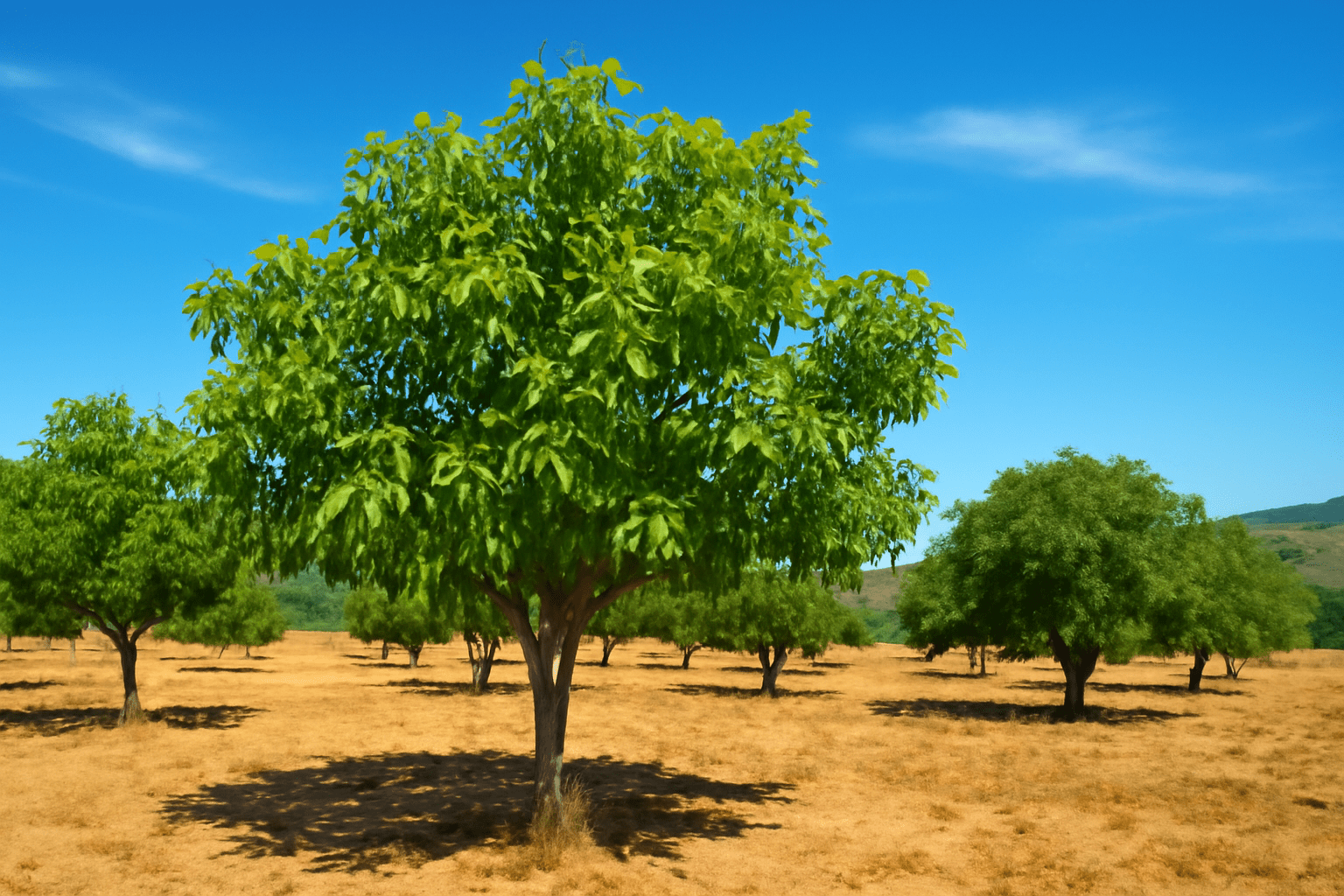
🌡️🌞 Temperature: Warm Summers, Mild Winters 🌞🌡️
Walnut trees grow best in temperate climates 🌍 with a balance of warm summers 🌞 and cool, but not harsh, winters ❄️. Here’s what they need:Ideal Summer Temperatures 🌞:
Between 75°F and 85°F (24°C to 29°C) for optimal growth 🌱 and nut production 🌰.Winter Chilling Hours ❄️:
Most walnut trees require 400 to 1,500 chilling hours (temperatures between 32°F and 45°F or 0°C to 7°C) during dormancy to produce nuts 🌰.Frost Sensitivity 🌨️:
Late spring frosts 🥶 can damage new growth 🌱 and blossoms 🌸, so areas with a long frost-free growing season are ideal 🌞.💧🌍 Rainfall and Water Needs 🌍💧
Walnut trees prefer regions with moderate rainfall 🌧️ or access to irrigation 💦. Here’s what to consider:Annual Rainfall 🌧️:
Around 30 to 50 inches (760 to 1,270 mm) is ideal 🌱, but they can tolerate less with proper irrigation 💧.Drought Tolerance 🌵:
Established trees 🌳 can handle short periods of drought 🌞, but young trees 🌱 need consistent moisture 💧.🌍🌿 Regions with Ideal Climates 🌿🌍
Walnut trees thrive 🌳 in specific climates around the world 🌎. Some of the best regions include:Mediterranean Climates 🌞:
With warm, dry summers 🌞 and mild, wet winters 🌧️, areas like California 🇺🇸, southern Europe 🇪🇺, and parts of Australia 🇦🇺 are perfect for English walnuts 🌰.Temperate Zones 🌱:
Eastern United States 🇺🇸, parts of Canada 🇨🇦, and northern Europe 🇬🇧 are ideal for black walnuts 🌰 and other cold-tolerant varieties 🌳.High Altitudes in Tropics 🌄:
In countries like India 🇮🇳 and Chile 🇨🇱, walnut trees 🌰 can thrive in cooler, high-altitude regions 🏔️.🌬️🌿 Wind and Humidity 🌿🌬️
Walnut trees prefer calm 🌬️, low-humidity environments 🌱. Strong winds 💨 can damage their branches 🌳 and reduce nut yields 🌰, while high humidity increases the risk of diseases like walnut blight 🦠.🏡🌰 Can You Grow Walnuts in Your Area? 🌰🏡
If you’re wondering whether walnut trees 🌳 will grow in your area 🌍, ask yourself these questions:- Does your region have a temperate climate 🌞 with warm summers 🌞 and mild winters ❄️?
- Can your soil drain well 🌍 and stay fertile 🌱?
- Is there enough rainfall 🌧️ or irrigation 💧 available to support the tree’s water needs 🌱?
🌟🌰 Fun Fact 🌰🌟
California 🇺🇸 produces over 65% of the world’s walnuts 🌰, thanks to its near-perfect Mediterranean climate 🌞. By understanding the ideal climates 🌞 for walnut trees 🌳, you can ensure they grow strong 💪 and healthy 🌱. Next, let’s dig into the specific soil and growing conditions 🌍 that make these trees truly flourish 🌳! ✨🌍🌳 Best Regions for Growing Walnut Trees 🌳🌍
Walnut trees may be adaptable 🌱, but they thrive best in specific regions where the climate 🌞, soil 🌍, and environmental conditions 🌿 align perfectly with their needs. Whether you’re planning to plant a walnut orchard 🌳 or just a single tree 🌰, knowing the best regions can help you make an informed decision. Let’s take a closer look at where walnut trees grow best around the world! 🌱🌎🌰 Top Walnut-Growing Regions Worldwide 🌰🌎
Here are some of the best regions where walnut trees flourish 🌳:1️⃣ North America 🇺🇸
United States 🇺🇸: California 🌞 is the walnut capital of the world 🌍, producing over 99% of the country’s commercial walnuts 🌰. Its Mediterranean-like climate 🌞, with warm summers 🌞 and mild winters ❄️, is ideal for English walnuts 🌰. The eastern U.S., including states like Indiana, Missouri, and Pennsylvania 🌾, is home to black walnuts 🌰, which thrive in temperate zones 🌱 with fertile soils 🌍. Canada 🇨🇦: Southern regions, particularly in Ontario, are suitable for cold-hardy walnut varieties like black walnut 🌳.2️⃣ Europe 🇪🇺
Southern Europe 🇪🇺: Countries like France 🇫🇷, Italy 🇮🇹, Spain 🇪🇸, and Romania 🇷🇴 are major producers of walnuts 🌰. Their warm summers 🌞 and moderate winters ❄️ create the perfect environment for English walnuts 🌰. Eastern Europe 🇷🇴: Ukraine 🇺🇦 and Moldova 🇲🇩 are emerging as significant walnut producers due to their favorable climates 🌤️ and rich soils 🌿.3️⃣ Asia 🇨🇳
China 🇨🇳: The largest walnut producer 🌰 in the world 🌎, China 🇨🇳 grows walnuts 🌰 in regions with varied climates 🌱, including temperate and subtropical areas 🌿. India 🇮🇳: Northern states like Jammu and Kashmir, Himachal Pradesh, and Uttarakhand 🌾 are ideal for walnut cultivation 🌰, especially in high-altitude regions 🏔️ with cooler climates 🌱. Iran 🇮🇷: Known as one of the original homes 🏡 of English walnuts 🌰, Iran 🇮🇷 continues to produce high-quality nuts 🌰 in its temperate regions 🌳.4️⃣ South America 🇦🇷
Chile 🇨🇱 and Argentina 🇦🇷: These countries have become global walnut powerhouses 💪, thanks to their Mediterranean-like climates 🌞. Chile 🇨🇱, in particular, exports large quantities of high-quality walnuts 🌰.5️⃣ Australia 🇦🇺 and New Zealand 🇳🇿
Australia 🇦🇺: Southern regions like Tasmania 🌳 and parts of Victoria and New South Wales 🌿 are ideal for walnut cultivation 🌰 due to their temperate climates 🌤️. New Zealand 🇳🇿: Cooler areas with fertile soils 🌱 support walnut production 🌳, especially for small-scale growers 🌾.🗺️🌳 What Makes These Regions Ideal? 🌳🗺️
Walnut trees thrive 🌳 in regions with:- Temperate Climates 🌞: Warm summers 🌞 and mild winters ❄️ are key.
- Fertile, Well-Drained Soils 🌍: Rich soils 🌱 with good drainage help trees grow strong 🌳 and produce high yields 🌰.
- Adequate Rainfall 🌧️ or Irrigation 💦: Consistent water 💧 supply is necessary, especially during the growing season 🌱.
- Long Frost-Free Periods 🌞: Late spring frosts ❄️ can damage blossoms 🌸, so areas with extended frost-free seasons 🌞 are preferred 🌱.
🌳 Can You Grow Walnuts in Your Region? 🌳
If you’re not in one of the major walnut-growing regions 🌎, don’t worry! Many walnut tree varieties 🌳 are adaptable 🌱. For example:- English Walnut 🌰: Best for areas with Mediterranean or temperate climates 🌞.
- Black Walnut 🌰: Thrives in colder regions 🏔️ with fertile soils 🌱.
- Cold-Hardy Hybrids 🌳: Developed for regions with harsher winters ❄️, like northern U.S. 🇺🇸 and Canada 🇨🇦.
🌟🌰 Fun Fact 🌰🌟
Chile’s walnut exports 🌰 are so successful because its harvest season 🌱 occurs opposite to the Northern Hemisphere’s 🌍, allowing fresh walnuts 🌰 to hit global markets year-round 🌏! ✈️ By focusing on the best regions 🌍 for walnut trees 🌳, you can determine whether your area 🌍 has the right conditions—or find a variety 🌱 that works for your climate 🌞. Up next, let’s talk about the specific soil requirements 🌍 walnut trees 🌳 need to truly thrive! 🌳✨☀️🌳 Ideal Growing Conditions for Walnut Trees 🌳☀️
Walnut trees are majestic and productive 🌳, but to grow them successfully 🌱, you need to provide the right environment 🌍. From soil quality 🌱 to sunlight 🌞, water 💧, and spacing 🌿, every detail matters. Here’s a comprehensive guide to the ideal growing conditions 🌱 for walnut trees 🌳 to help you cultivate healthy trees 🌳 and abundant harvests 🌰! 🌱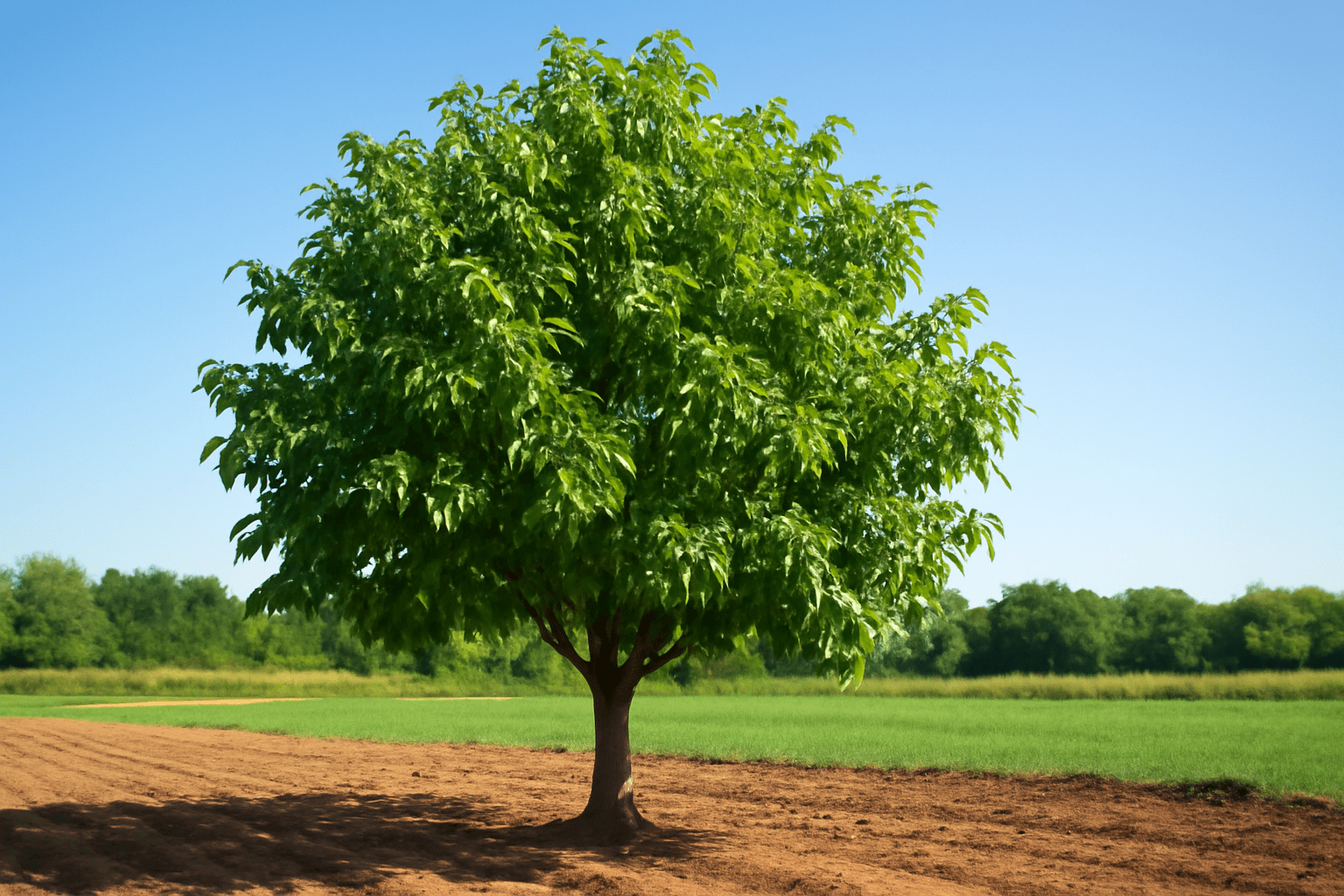
☀️🌡️ 1. Climate Requirements 🌡️☀️
Walnut trees thrive 🌳 in temperate climates with distinct seasons 🌍.Temperature 🌞:
- Warm summers 🌞 between 75°F and 85°F (24°C to 29°C) are ideal for growth 🌱 and nut production 🌰.
- Mild winters ❄️ are preferred, but they require 400–1,500 chilling hours (temperatures between 32°F and 45°F or 0°C to 7°C) during dormancy for proper flowering 🌸 and nut development 🌰.
- Avoid regions with harsh winters 🥶 or late spring frosts 🌨️, as these can damage blossoms 🌸 and reduce yields 🌰.
Frost-Free Growing Season 🌳:
A long frost-free period (at least 140–180 days) is essential for the nuts 🌰 to mature properly 🌞.🌱💧 2. Soil Requirements 💧🌱
Walnut trees are particular about their soil 🌍. Here’s what they need:Soil Type 🌍:
- Deep, fertile, and well-drained soils 🌱 are ideal.
- Loam or sandy loam soils 🌿 with good aeration 🌬️ are best. Avoid heavy clay or compacted soils 🌍 that retain water 💧.
Soil pH 🌱:
- The optimal pH range is 6.0 to 7.5 (slightly acidic to neutral) 🌿.
- If the soil is too acidic or alkaline, amend it before planting 🌱.
Depth 🌳:
- Walnut trees have deep root systems 🌳, so the soil should be at least 5–6 feet (1.5–1.8 meters) deep 🌱 for proper root development 🌳.
💧🌍 3. Watering Needs 🌍💧
Walnut trees require consistent moisture 💧, especially during their early years 🌱 and the growing season 🌿.Rainfall 🌧️:
- Ideal annual rainfall is around 30–50 inches (760–1,270 mm) 🌧️.
- In drier regions 🌵, irrigation 💦 is essential to supplement rainfall 🌧️.
Drainage 🌍:
- While they need moisture 💧, walnut trees 🌳 cannot tolerate waterlogged soils 🌍. Ensure proper drainage 💦 to prevent root rot 🦠.
Young Trees 🌱:
- Water regularly 💧 during the first 3–5 years 🌱 until the tree 🌳 is established 🌿.
☀️🌞 4. Sunlight 🌞☀️
Walnut trees 🌳 are sun-loving 🌞 and require full sun 🌞 to thrive 🌱.Daily Sunlight 🌞:
- At least 6–8 hours of direct sunlight ☀️ per day is necessary for healthy growth 🌱 and nut production 🌰.
Avoid Shading 🌳:
- Ensure the tree 🌳 is planted in an open area 🌱 where it won’t compete for sunlight 🌞 with nearby buildings 🏠 or other trees 🌳.
🌬️🌿 5. Wind Protection 🌿🌬️
While walnut trees 🌳 can tolerate some wind 🌬️, strong winds 💨 can damage branches 🌳 and reduce nut yields 🌰.Sheltered Areas 🌳:
- Plant in locations protected from high winds 🌬️, such as near windbreaks 🌿 or natural barriers 🏞️.
Avoid Crowding 🌳:
- Proper spacing 🌿 between trees 🌳 ensures airflow 🌬️ and reduces the risk of disease 🦠.
🌳🌱 6. Spacing and Planting 🌱🌳
Walnut trees grow large 🌳 and need plenty of space 🌍 to spread their roots 🌱 and canopy 🌳.Spacing 🌳:
- For commercial orchards 🌱, space trees 🌳 40–60 feet (12–18 meters) apart 🌳.
- For black walnuts 🌰, allow even more space due to their larger size 🌳.
Depth 🌱:
- Plant the tree 🌳 at the same depth as it was in the nursery 🏡. The root collar 🌱 (where the trunk meets the roots) should be level with the soil surface 🌍.
🦠🌳 7. Disease and Pest Management 🌳🦠
Walnut trees 🌳 are susceptible to certain diseases 🦠 and pests 🐛, so maintaining healthy growing conditions 🌱 is crucial:Common Diseases 🦠:
- Walnut blight 🦠 (caused by bacteria) is a common issue in humid regions 🌧️.
- Root rot 🦠 can occur in poorly drained soils 🌍.
Pests 🐛:
- Aphids 🐜, caterpillars 🐛, and walnut husk flies 🦠 can damage trees 🌳 and nuts 🌰.
Prevention 🌱:
- Ensure proper spacing 🌳 for airflow 🌬️, prune ✂️ dead or diseased branches 🌿, and monitor for pests 🐛 regularly.
🌟🌰 8. Special Considerations: Juglone Toxicity 🌰🌟
Walnut trees 🌳 produce a natural chemical called juglone 🧪, which can inhibit the growth 🌱 of certain plants nearby 🌿.Affected Plants 🌸:
- Tomatoes 🍅, potatoes 🥔, peppers 🌶️, and some flowers 🌺 (like azaleas 🌸) are sensitive to juglone 🧪.
Solution 🌱:
- Avoid planting sensitive plants 🌱 within the tree’s root zone, which can extend far beyond the canopy 🌳.
🌟🌰 Fun Fact 🌰🌟
Did you know walnut trees 🌳 can live for over 200 years 🕰️? With proper care 🌱, a single tree 🌳 can provide nuts 🌰 and shade 🌳 for generations! 🌰✨ By providing these ideal growing conditions 🌱, your walnut trees 🌳 will flourish 🌳, producing healthy nuts 🌰 and adding beauty 🌸 to your landscape for years to come 🌿. Ready to plant 🌱? Let’s get started! 🌳🌞🌳⚠️ Challenges and Common Problems in Growing Walnut Trees ⚠️🌳
Growing walnut trees 🌳 can be a rewarding endeavor 🌱, but it comes with its fair share of challenges ⚠️. From pests 🦠 and diseases 🦠 to environmental stress 🌞 and soil issues 🌍, walnut trees require attentive care 🧑🌾 to thrive 🌱. Let’s look at the most common problems 💡 growers face and how to address them effectively 🛠️. 🌱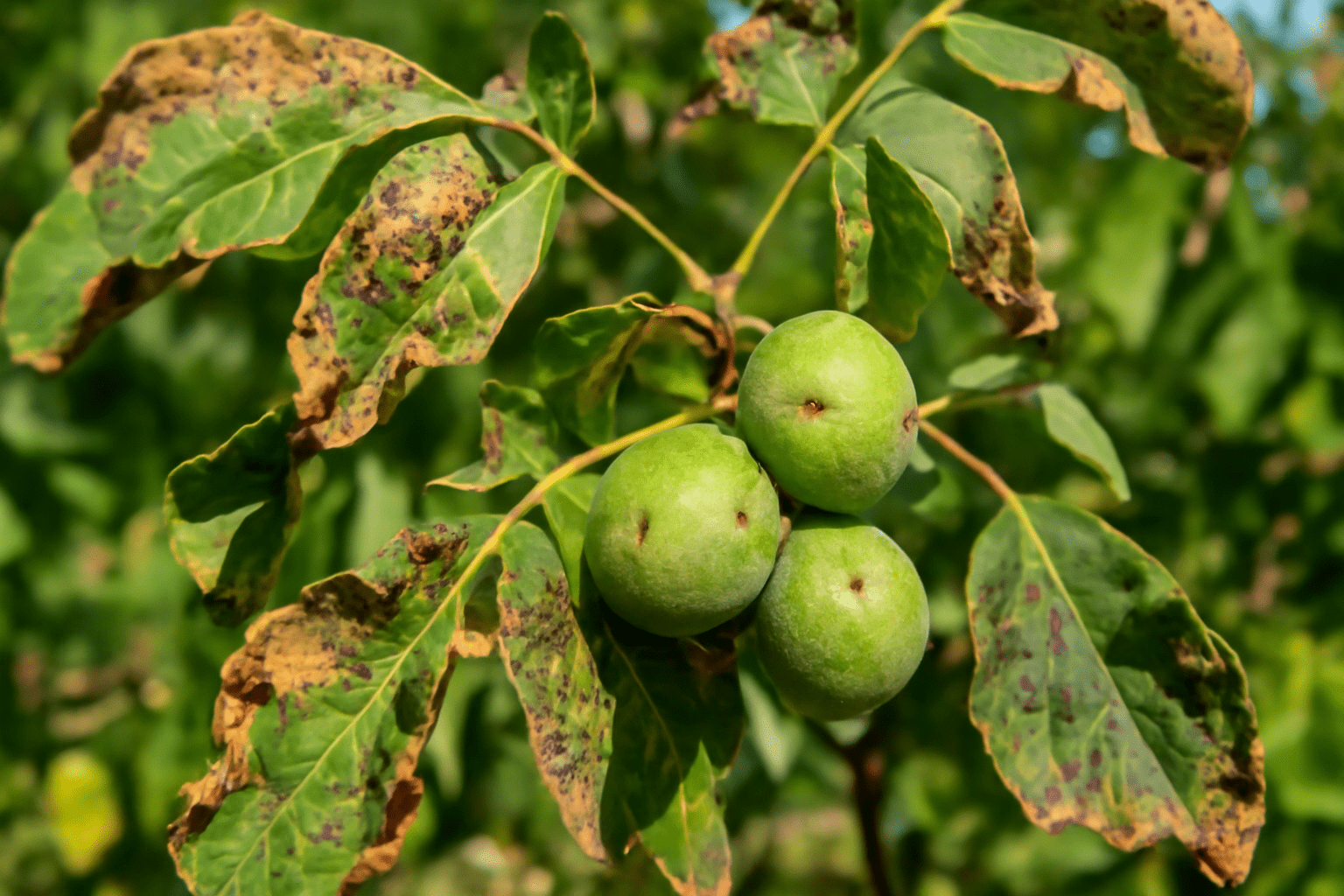
🦠⚠️ 1. Diseases ⚠️🦠
Walnut trees 🌳 are susceptible to several diseases 🦠 that can impact their health 🌱 and nut production 🌰.a) Walnut Blight 🦠
- Cause: A bacterial disease caused by Xanthomonas arboricola pv. juglandis 🦠.
- Symptoms: Black spots on leaves 🍂, twigs 🌿, and nuts 🌰; premature nut drop 🍂.
- Prevention/Treatment:
- Apply copper-based fungicides during wet weather 🌧️.
- Ensure good airflow 🌬️ by pruning ✂️ and spacing trees 🌳 properly.
- Plant resistant varieties if available 🌱.
b) Root Rot 🦠
- Cause: Fungal pathogens like Phytophthora in poorly drained soils 🌍.
- Symptoms: Yellowing leaves 🍂, stunted growth 🌱, and tree decline 🌳.
- Prevention/Treatment:
- Avoid waterlogged soils 🌧️; ensure proper drainage 💧.
- Use rootstock resistant to Phytophthora 🌱.
c) Canker Diseases 🦠
- Cause: Fungi like Botryosphaeria or Thyronectria 🦠.
- Symptoms: Dark, sunken areas on trunks 🌳 and branches 🌿, leading to dieback 🍂.
- Prevention/Treatment:
- Prune ✂️ infected branches 🍂 and dispose of them 🗑️.
- Avoid wounding the tree 🌳, as fungi enter through injuries ⚠️.
d) Thousand Cankers Disease 🦠
- Cause: A combination of Geosmithia morbida fungus and walnut twig beetles 🐞.
- Symptoms: Small cankers on branches 🌿, twig dieback 🍂, and eventual tree death 💀.
- Prevention/Treatment:
- Monitor for twig beetles 🐞 and remove infested trees 🌳.
- Avoid moving infected wood to new areas 🌍.
🐛⚠️ 2. Pests ⚠️🐛
Walnut trees 🌳 are vulnerable to several pests 🦠 that can damage leaves 🍂, nuts 🌰, and wood 🌳.a) Walnut Husk Fly 🦠
- Symptoms: Brown, shriveled husks 🌰 and discolored nuts 🌰.
- Control:
- Use insect traps 🪲 to monitor and reduce populations 🦠.
- Apply insecticides during the fly’s active season (summer ☀️).
b) Codling Moth 🦋
- Symptoms: Worms 🐛 inside nuts 🌰, causing nut drop 🍂.
- Control:
- Use pheromone traps 🧲 to disrupt mating 🦋.
- Apply insecticides at the right time (after egg-laying 🐛).
c) Aphids 🐜
- Symptoms: Yellowing leaves 🍂, sticky residue (honeydew 🍯), and sooty mold 🦠.
- Control:
- Introduce natural predators 🦉 like ladybugs 🦋.
- Use insecticidal soaps 🧴 or neem oil 🌿.
d) Walnut Twig Beetle 🪲
- Symptoms: Tiny holes in bark 🌳 and cankers caused by associated fungus (Thousand Cankers Disease 🦠).
- Control:
- Remove and destroy infested wood 🌳.
- Monitor trees 🌳 regularly for signs of infestation 🦠.
🌱⚠️ 3. Environmental Stress ⚠️🌱
Walnut trees 🌳 are sensitive to environmental factors 🌍, which can lead to reduced growth 🌱 and nut production 🌰.a) Late Spring Frosts ❄️
- Problem: Frost 🌨️ can damage blossoms 🌸 and young leaves 🍂, reducing nut yield 🌰.
- Solution:
- Plant in frost-free areas 🌱 or on slopes ⛰️ where cold air drains away.
- Use frost protection methods, like row covers 🧑🌾 or sprinklers 🌧️, during cold snaps ❄️.
b) Drought Stress 🌵
- Problem: Lack of water 💧 can stunt growth 🌱 and reduce nut quality 🌰.
- Solution:
- Water trees 🌳 regularly 💦, especially during dry periods 🌞 and the growing season 🌱.
- Mulch around the base 🌳 to retain soil moisture 🌱.
c) Heat Stress 🌞
- Problem: Excessive heat ☀️ can cause leaf scorch 🌿 and nut drop 🌰.
- Solution:
- Provide adequate irrigation 💧 during heat waves 🌞.
- Plant trees 🌳 in areas with partial afternoon shade 🌥️ if heat is a recurring issue 🌞.
🪵⚠️ 4. Soil and Nutrient Issues ⚠️🪵
Walnut trees 🌳 are particular about their soil 🌍 and nutrient needs 🌱.a) Poor Drainage 💧
- Problem: Waterlogged soils 💧 can lead to root rot 🦠 and tree decline 🌳.
- Solution:
- Ensure soil is well-drained before planting 🌍.
- Avoid overwatering 💧, especially in heavy soils 🌍.
b) Nutrient Deficiencies 🌱
- Problem: Yellowing leaves 🍂, poor growth 🌱, and low nut production 🌰 can result from nutrient imbalances 🌿.
- Common Deficiencies:
- Nitrogen 🟩: Yellowing leaves 🍂 and stunted growth 🌱.
- Zinc 🛠️: Smaller leaves 🍂 and poor nut development 🌰.
- Potassium 🌿: Leaf scorch 🌿 and reduced nut quality 🌰.
- Solution:
- Test soil 🌍 regularly and apply fertilizers 💧 as needed.
- Use foliar sprays for micronutrient deficiencies 🌿 like zinc 🛠️.
🌿⚠️ 5. Juglone Toxicity ⚠️🌿
Walnut trees 🌳 produce a natural chemical called juglone 🧪, which can inhibit the growth 🌱 of certain plants nearby 🌿.- Problem: Sensitive plants 🌸 like tomatoes 🍅, peppers 🌶️, and azaleas 🌺 may wilt or die 💀 if planted too close to walnut trees 🌳.
- Solution:
- Avoid planting sensitive crops 🌾 within the tree’s root zone 🌳 (up to 50–80 feet or 15–24 meters).
- Choose juglone-tolerant plants 🌱 like beans 🫘, corn 🌽, or grasses 🌿.
🌬️⚠️ 6. Wind Damage ⚠️🌬️
Walnut trees 🌳 have large canopies 🌳 and can suffer from broken branches 🌳 during strong winds 💨.- Solution:
- Plant in sheltered areas 🌳 or use windbreaks 🌲.
- Prune ✂️ regularly to reduce the risk of limb breakage 🌳.
🧑🌾⚠️ 7. Maintenance Challenges ⚠️🧑🌾
Walnut trees 🌳 require consistent care 🧑🌾, which can be time-consuming ⏳.- Large Size 🌳: Their size makes pruning ✂️ and harvesting 🌰 challenging.
- Messy Droppings 🍂: Fallen nuts 🌰 and husks 🌰 can create a mess in yards or orchards 🌿.
- Solution:
- Use proper tools for pruning ✂️ and harvesting 🌰.
- Plan for regular cleanup 🧹 around the tree 🌳.
🌟🌰 Fun Fact 🌰🌟
The walnut tree’s 🌳 natural defense 🛡️, juglone 🧪, is so effective that it has inspired research into eco-friendly herbicides! 🌰✨ By understanding these challenges ⚠️ and taking proactive steps 🌱, you can grow healthy walnut trees 🌳 that provide shade 🌳, beauty 🌸, and a bountiful harvest 🌰 for years to come 🌿. 🌳🌞🌳✨ How to Plant and Care for Walnut Trees 🌳✨
Walnut trees 🌳 are not only beautiful 🌸 but also highly productive 🌰, providing delicious nuts 🌰 and valuable wood 🪵. However, they require proper planting 🌱 and ongoing care 🧑🌾 to thrive 🌱. Here’s a step-by-step guide to help you successfully plant 🌱 and care for walnut trees 🌳, ensuring healthy growth 🌿 and abundant harvests 🌰! 🌱
🌱🌍 1. Choosing the Right Walnut Tree Variety 🌍🌱
Before planting 🌱, select the walnut variety 🌰 that best suits your climate 🌞 and purpose 🎯.Popular Varieties 🌰:
- English Walnut (Juglans regia): Ideal for nut production 🌰; thrives in temperate climates 🌞 with mild winters ❄️.
- Black Walnut (Juglans nigra): Known for its high-quality wood 🪵 and distinctively flavored nuts 🌰; grows well in colder climates 🌾.
- Hybrid Varieties: Cold-hardy ❄️ and disease-resistant hybrids 🌱 are available for challenging climates 🌍.
Considerations 🌱:
- Choose a variety suited to your region’s temperature 🌡️, soil 🌍, and rainfall 🌧️.
- Ensure pollination compatibility 💐 if planting multiple trees 🌳 (some varieties may require cross-pollination 🔄).
🌍🌳 2. Selecting the Perfect Planting Site 🌳🌍
Walnut trees 🌳 grow large 🌱 and need plenty of space 🌍, sunlight 🌞, and well-drained soil 🌱 to thrive 🌿.Site Requirements 🌱:
- Sunlight 🌞: Full sun 🌞 (6–8 hours of direct sunlight daily).
- Soil 🌍:
- Deep, fertile 🌱, and well-drained soil 🌍 is essential.
- Avoid heavy clay or poorly drained soils 🌿.
- Soil pH should be slightly acidic to neutral (6.0–7.5) 🌿.
Space 🌱:
- Allow 40–60 feet (12–18 meters) between trees 🌳.
- Ensure enough room for the tree’s roots 🌱 and canopy 🌳 to spread.
Avoid Planting Near 🚫:
- Juglone-sensitive plants 🌸 (e.g., tomatoes 🍅, peppers 🌶️, and azaleas 🌺).
- Buildings 🏠, fences 🚧, or utility lines ⚡ that could interfere with the tree’s growth 🌳.
🌱🌳 3. How to Plant a Walnut Tree 🌳🌱
Follow these steps to plant 🌱 your walnut tree 🌳 properly:a) Timing 🌱:
- Plant in early spring 🌞 or late fall 🍂 when the tree 🌳 is dormant.
b) Prepare the Planting Hole 🌍:
- Dig a hole 🕳️ 2–3 times wider than the tree’s root ball 🌱 and just as deep.
- Loosen the soil at the bottom of the hole to encourage root growth 🌱.
c) Planting the Tree 🌳:
- Place the tree 🌳 in the hole so the root collar (where the trunk meets the roots) is level with the soil surface 🌍.
- Spread the roots gently 🌱 to avoid crowding.
- Fill the hole with soil 🌍, tamping it down lightly to remove air pockets 🌱.
- Water thoroughly 💧 to settle the soil 🌍.
d) Mulching 🌿:
- Apply a 2–4 inch (5–10 cm) layer of mulch 🍂 around the base of the tree 🌳, keeping it a few inches away from the trunk 🌳.
- Mulch helps retain moisture 💧, regulate soil temperature 🌞, and suppress weeds 🌱.
💧🌱 4. Watering and Irrigation 🌱💧
Walnut trees 🌳 need consistent moisture 💧, especially during their early years 🌱.Watering Guidelines 🌿:
- Young Trees 🌱: Water deeply once a week 💧 during the growing season 🌞.
- Mature Trees 🌳: Established trees 🌳 are more drought-tolerant 🌵 but still need occasional watering 💦 during dry periods 🌞.
- Avoid overwatering 🚫, as walnut trees 🌳 dislike waterlogged soils 💧.
🌿🌱 5. Fertilizing Walnut Trees 🌱🌿
Walnut trees 🌳 benefit from nutrient-rich soil 🌍, but over-fertilizing 🌱 can harm them.Fertilizer Tips 🌱:
- Test your soil 🌍 before applying fertilizer 🧑🌾 to determine nutrient needs.
- Nitrogen 🟩: Apply a nitrogen-rich fertilizer 🌱 in early spring 🌞 to promote growth 🌱.
- Micronutrients 🌿: Zinc 🛠️ is particularly important for walnut trees 🌳. If leaves 🍂 appear small or yellowed, apply a zinc foliar spray 💧.
- Avoid fertilizing in late summer 🌞 or fall 🍂, as this can encourage new growth 🌱 that may not harden before winter ❄️.
✂️🌳 6. Pruning Walnut Trees 🌳✂️
Pruning ✂️ is essential for shaping the tree 🌳, improving airflow 🌬️, and removing dead or diseased branches 🌿.When to Prune 🌱:
- Prune in late winter ❄️ or early spring 🌞 while the tree 🌳 is dormant.
How to Prune 🌳:
- Remove dead, damaged, or diseased branches 🌿.
- Thin out crowded branches 🌳 to improve light penetration 🌞 and airflow 🌬️.
- Shape the tree 🌳 by removing low-hanging or crossing branches 🌿.
🐛🌱 7. Managing Pests and Diseases 🌱🐛
Walnut trees 🌳 are susceptible to pests 🦠 and diseases 🦠, so monitor them regularly 👀 and take preventive measures 🛠️.Common Problems 🌱:
- Walnut Blight 🦠: Use copper-based fungicides during wet weather 🌧️.
- Walnut Husk Fly 🦠: Monitor with traps 🪲 and apply insecticides if needed 🌱.
- Aphids 🐜: Use insecticidal soap 🧴 or introduce natural predators 🦉 like ladybugs 🦋.
- Root Rot 🦠: Ensure proper soil drainage 💧 to prevent fungal infections 🦠.
🌬️🌞 8. Protecting Against Environmental Stress 🌞🌬️
Walnut trees 🌳 can be affected by frost ❄️, drought 🌵, and heat 🌞.Tips to Protect Your Tree 🌱:
- Frost ❄️: Cover young trees 🌱 with frost blankets during late spring frosts 🌨️.
- Drought 🌵: Mulch around the base 🌳 to retain moisture 💧 and water deeply 💦 during dry spells 🌞.
- Heat 🌞: Provide extra water 💧 during heat waves 🌞 to prevent leaf scorch 🌿 and nut drop 🌰.

⏳🌳 9. Patience: Walnut Trees Take Time to Mature 🌳⏳
Walnut trees 🌳 are slow-growing 🌱 and take several years 🌱 to produce nuts 🌰.Production Timeline 🌰:
- English Walnuts 🌰: Begin producing nuts in 4–7 years 🌳.
- Black Walnuts 🌰: May take 10–15 years 🌳 to produce nuts 🌰.
- Nut production increases as the tree matures 🌳 and peaks after 20–30 years 🌳.
🌟🌰 10. Harvesting Walnuts 🌰🌟
Once your tree 🌳 begins producing nuts 🌰, you’ll need to harvest them carefully 🧑🌾.How to Harvest 🌰:
- Wait until the nuts fall naturally from the tree 🌳 (usually in late summer 🌞 or fall 🍂).
- Collect the nuts 🌰 promptly to prevent mold or pest damage 🦠.
- Remove the husks 🌰 and wash the nuts 🌰.
- Dry the nuts 🌰 in a well-ventilated area 🌬️ for 1–2 weeks before storing them 🏠.
🌟🌰 Fun Fact 🌰🌟
A mature walnut tree 🌳 can produce 50–80 pounds (22–36 kg) of nuts 🌰 per year! 🌰✨ By following these steps 🌱, you’ll set your walnut tree 🌳 up for success 🌳, ensuring it grows strong 💪, healthy 🌱, and productive 🌰 for generations to come 🌳. Ready to plant 🌱 your walnut tree 🌳? Let’s get started! 🌳🌞🌳✨ Final Thoughts on Growing Walnut Trees 🌰✨
Growing walnut trees 🌳 is a rewarding journey 🌱 that requires patience ⏳, dedication 🧑🌾, and proper care 💧. These majestic trees 🌳 not only provide delicious, nutritious nuts 🌰 but also enhance the beauty 🌸 of your landscape 🏞️ and can even serve as a long-term investment 💰 due to their valuable wood 🪵. However, they come with their challenges ⚠️, including susceptibility to pests 🦠, diseases 🦠, and environmental stress 🌞. By understanding their needs 🌱 and addressing potential problems proactively 💡, you can enjoy the many benefits walnut trees 🌳 offer for years to come 🌳.🌟🌱 Key Takeaways 🌱🌟:
- Choose Wisely 🌱: Select a walnut variety 🌰 suited to your climate 🌞, soil 🌍, and purpose 🎯 (nuts 🌰 or timber 🪵).
- Prepare the Site 🏡: Ensure deep, fertile 🌱, and well-drained soil 🌍 with plenty of sunlight 🌞 and space 🌳.
- Be Patient ⏳: Walnut trees 🌳 take time 🕰️ to mature, but the long-term rewards 🌰 are worth the wait 🌳.
- Care Consistently 💧: Regular watering 💦, fertilizing 🌿, pruning ✂️, and pest management 🦠 are essential for healthy growth 🌱 and high yields 🌰.
- Stay Vigilant 👀: Monitor for diseases 🦠, pests 🐛, and environmental stress 🌞 to address issues early ⏳.
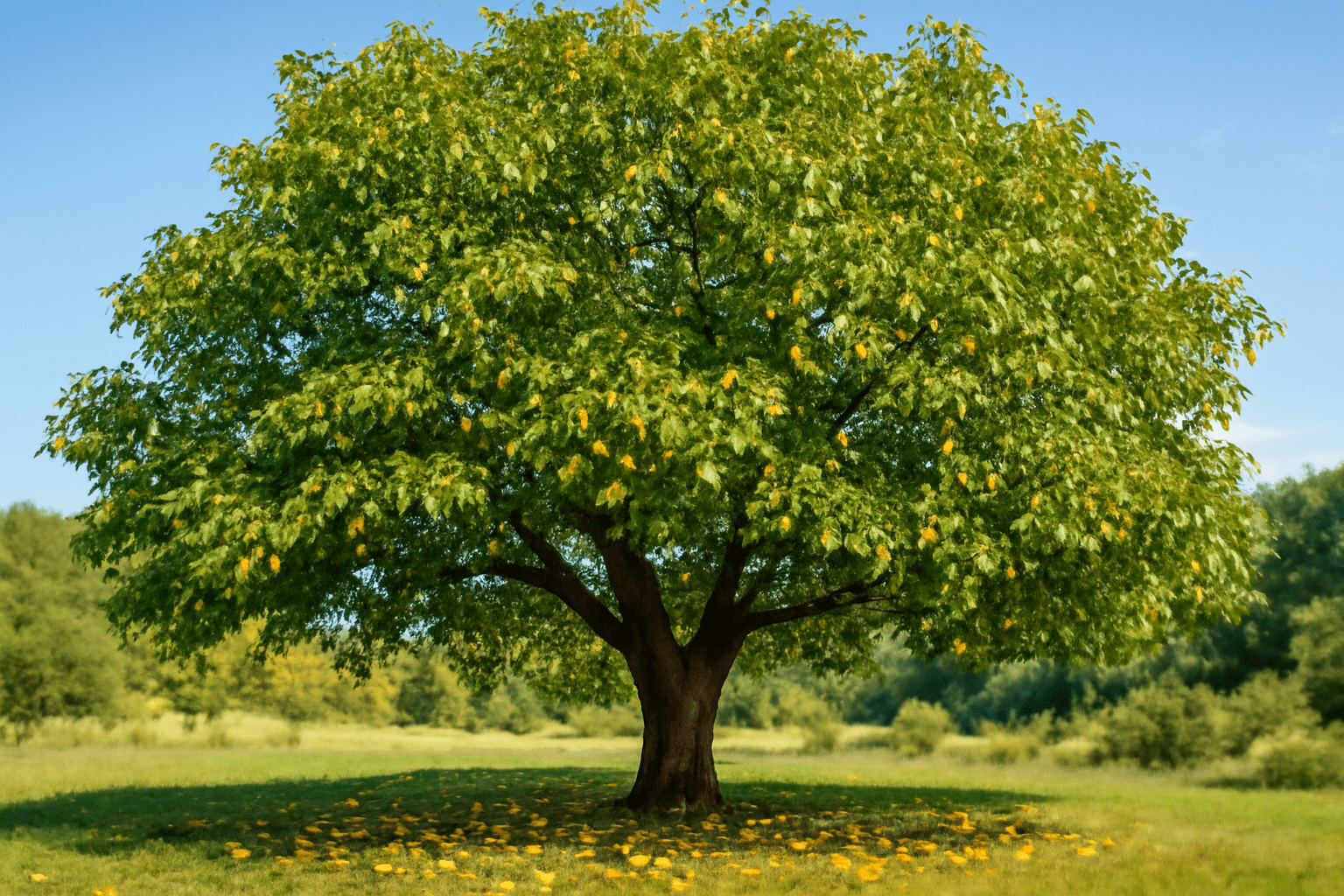
🌍🌳 Why Grow Walnut Trees? 🌳🌍
Walnut trees 🌳 are more than just nut producers 🌰—they are a legacy 🌱. Planting a walnut tree 🌳 is an investment 💰 in the future 🔮, providing food 🍴, shade 🌳, and even timber 🪵 for generations 🌳. Whether you’re growing them for personal enjoyment 🌸 or commercial purposes 💼, these trees 🌳 symbolize patience ⏳, growth 🌱, and sustainability 🌍.🌟🌰 Fun Fact to End On 🌰🌟:
A single mature walnut tree 🌳 can live for over 200 years 🕰️, making it a true gift 🎁 to future generations 🌱! 🌳✨ So, whether you’re planting your first walnut tree 🌱 or expanding an orchard 🌳, you’re embarking on a meaningful and fruitful endeavor 🌿. Happy growing! 🌱🌰Frequently Asked Questions (FAQ)
What climate is best for growing walnut trees?
Walnut trees thrive in temperate climates with warm summers (75–85°F or 24–29°C) and mild winters. They need a long frost-free growing season (140–180 days) and require 400–1,500 chilling hours during dormancy to produce nuts. Avoid areas with late spring frosts or extreme heat.
Where do walnut trees grow naturally?
Walnut trees are native to regions of Europe, Asia, and North America. English walnuts (Juglans regia) originated in Central Asia, while black walnuts (Juglans nigra) are native to the eastern United States. They grow naturally in forests, river valleys, and areas with deep, fertile soil.
Can walnut trees grow in cold climates?
Yes, certain walnut varieties, like black walnuts and cold-hardy hybrids, can tolerate colder climates. However, most walnut trees prefer regions with mild winters and are sensitive to late spring frosts, which can damage blossoms and reduce nut production.
What type of soil do walnut trees need?
Walnut trees require deep, fertile, and well-drained soil to thrive. Loamy or sandy loam soils with a pH between 6.0 and 7.5 are ideal. Avoid heavy clay or waterlogged soils, as they can cause root rot and stunt growth.
Can walnut trees grow in tropical or desert climates?
Walnut trees are not well-suited to tropical or desert climates. They need a cool dormancy period during winter and struggle in areas with excessive heat or humidity. However, with irrigation and proper care, they can grow in some arid regions with temperate conditions.
What are the best regions for growing walnut trees?
The best regions for growing walnut trees include California, Oregon, and Washington in the United States, as well as parts of Europe, China, and India. These areas offer the right combination of temperate climates, fertile soil, and long growing seasons.
Do walnut trees need full sun to grow?
Yes, walnut trees require full sun to grow and produce nuts. They need at least 6–8 hours of direct sunlight daily for healthy growth. Plant them in open areas away from buildings or other trees that might block sunlight.
How much water do walnut trees need?
Walnut trees need consistent moisture, especially during their early years and the growing season. They prefer 30–50 inches (760–1,270 mm) of annual rainfall or supplemental irrigation. However, they cannot tolerate waterlogged soils, so proper drainage is essential.
